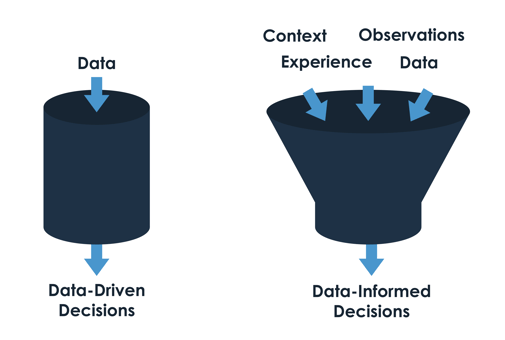
With the growing interest in educational data analysis, it’s clear schools are committed to making informed decisions that benefit their students. However, there's a big difference between blindly following data and using it as a tool to guide our decision-making. In this blog, we'll explore the advantages and disadvantages of being data-driven versus data-informed in schools, and why the latter might be the way to go.
What is data-driven decision-making?
A data-driven decision-making approach relies solely on data, particularly quantitative analysis, to inform and guide the decision-making process.
In her book "I'm Not a Numbers Person", former teacher and data expert Dr Selena Fisk compares being data-driven to a horse wearing blinders in a race – they race toward the finish line without considering their surroundings, or what the other racers are doing.
This type of decision-making can be more efficient, as it can quickly identify patterns and correlations in the data. However, it can also be limited in its ability to account for context, teacher observations, or other factors that may influence and add value to the data.
The goal of the data-driven approach is to make decisions that are objective and grounded in evidence, rather than relying on intuition and personal experiences.
What is data-informed decision-making?
In data-informed decision-making, data is still an important component, but it is used as a tool to guide decision-making, rather than being the sole basis for it.
Data-informed decision-making takes a more flexible approach that incorporates both quantitative data and qualitative information. In this approach, data is used to inform and support decision-making alongside other factors, such as personal expertise, professional judgment, and context.
Being data-informed is beneficial in complex situations where a range of factors must be considered to make informed decisions, which is why it is usually the better approach for schools.
This type of decision-making allows for a more holistic approach and can lead to better decisions.
Why schools should strive to be data-informed
“Organisations should always aspire to be data-informed if they want to effectively harness the power of data, but never driven by it.”
- Dr Selena Fisk
Overall, the main benefit of data-informed decision-making is that it allows for more comprehensive and nuanced decisions.
A data-informed teacher uses data to inform their practice, while considering their own observations and conclusions, forming a broader more informed picture of the whole student experience.
Data-driven decision-making, on the other hand, while useful for identifying patterns and correlations, simply cannot account for all of the factors that are important in making student-focused decisions.
Can data replace teacher insight?
Short answer? No, it can’t. Teachers understand, care about, and interact with their students daily, gaining valuable insight into things that can’t always be neatly presented in tables or graphs. Teachers witness student traits like attitude, motivation, creativity, or drive, and have an understanding of their current situation, stress levels and external factors that could impact their outcomes. These insights are invaluable, and no amount of data collection and analysis will ever fully replace them.
The analysis of educational data is meant to support teachers in their decision-making by identifying trends and patterns in academic results, pastoral incidents, extra-curricular activities or attendance, without disregarding their own experiences and conclusions.
In summary, data is not meant to make decisions, educators are - all data does is help them make informed ones.
How to Implement Data-Informed Approaches
One of the biggest roadblocks to effective data use is the time it takes to collect, sort, and analyse the vast amount of data held in your school. From attendance to assessments, extra-curricular to external results, your school holds an abundance of information, usually across multiple systems.
An ACER survey discovered that the average Australian teacher spends around 44 hours a week working, despite only being paid for 25 hours. With all the lesson planning, communicating with parents, marking, and the plethora of other work teachers put in outside their required hours, asking them to spend more time gathering and interpreting data from around your school is going to be a massive barrier to becoming data-informed.
If you want to create a data-informed culture at your school, consider ways to lessen or eliminate this time-consuming task, and allow teachers to focus on drawing insights from data, rather than burdening them with the task of data analysis.
To lessen this burden, ensure your educational data is easily accessible in one central location, as having to jump between systems to find the data they need is complicating the process for teachers and will discourage them from seeking these insights in future.
Implementing an analytics platform is one of the most efficient ways to facilitate this, by providing a single location for staff to access relevant data and reports. These platforms, like the Learning Analytics Suite, gather data from around your school and present it in easy-to-digest dashboards, allowing staff to gain valuable insights at a glance, without spending time hunting for information.
Teachers are already time-poor, wear many different hats and work an incredible number of hours outside their obligation, so automating this data analysis is one way to help alleviate some of that workload, whilst still providing them with the tools and time they need to make data-informed decisions.
Ultimately, an analytics platform can help reduce many of the barriers to data-informed practice in schools, reducing teacher workload as opposed to piling on more tasks, which is a common reason for overall resistance to change.
In conclusion, while data-driven decision-making can be useful for identifying patterns and correlations in data, it should not be the only basis for decision-making in schools. Data-informed decision-making, which incorporates both quantitative and qualitative information, is a more holistic approach that takes into account the complexities of the student experience.




